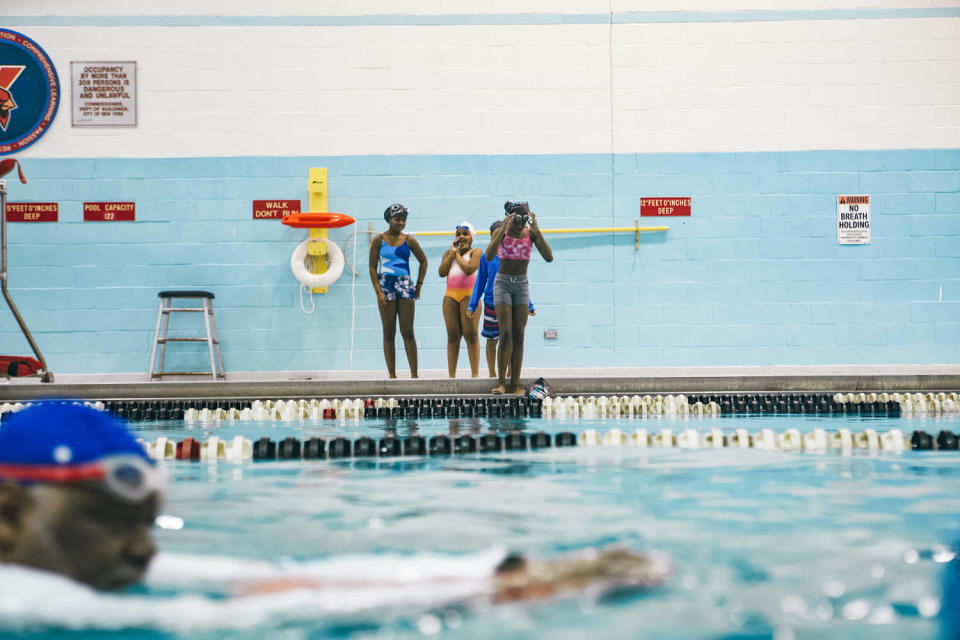Her goal is to defy the notion that Black people don't swim
Five years ago, Paulana Lamonier made public her goal to change the lives of countless people in the New York City area.
That goal also ended up changing her life.
The former collegiate swimmer at York College, in the Queens borough, tweeted in 2019 that she wanted to teach 30 Black people to swim. Lamonier, the daughter of Haitian immigrants, knew that learning to swim as a child changed the trajectory of her life. She met her best friends and learned the importance of perseverance and hard work over taking shortcuts.
“Swimming has given me a sense of purpose, a sense of drive,” Lamonier, 32, said.
Once she quickly surpassed that first goal, she set an even loftier one: to make swimming more affordable for everyone, particularly for Black children and adults. Two years later, Lamonier created Black People Will Swim, both a business and mantra, to do just that.
Keenly aware of the lifelong racial disparities in swimming, Lamonier can rattle off various stats like simple math equations. For instance, how Black children ages 10 to 14 are more than seven times as likely to drown than white children and overall, how 64% of Black kids have little to no swimming ability as compared to just 40% of white children.
“Swimming has claimed so many lives of Black people,” she said. “We deserve to have a space to learn without feeling discriminated against, without feeling as if we have to break the bank to learn this life skill. And, most importantly, it’s really a community.”
The increasing demand for the program year after year is evidence of its impact, Lamonier said. After teaching about 300 students in each of the first three years of its operation, she said Black People Will Swim now serves 300 people every six weeks, with a growing waiting list for each of the 48 group classes currently in session. And she keeps the classes relatively affordable, at about $30 per session, while similar programs may charge more than double.
Last spring, Lamonier left her career as a social media strategist to teach people to swim full time. She and about a dozen swim instructors on her all-Black staff teach children as young as 2 years old to adults well into their 50s at a pool at her alma mater.
After experiencing the challenges of not having access to an indoor pool in years prior and resorting to renting out pools in peoples’ backyards across New York City and Long Island, Lamonier values bringing the class to the pool at York College, a space within a community with the fewest public pool options of all five New York City boroughs. Queens residents have just 12% of the pool access in the city.
Home to more than 270,000 people, the Jamaica and Hollis section of Queens is 55% Black and 16% Latino, according to city data, with a poverty rate of 15%.
Majority-Black communities like those epitomize what Jeff Wiltse, author of “Contested Waters: A Social History of Swimming Pools in America,” described as having been hardest hit by the segregation and privatization of municipal pools across the U.S. in the late 1800s through 1900s. The long-lasting effects also help explain why swimming disparities existed then and still remain.
Today, New York City has less than 100 public pools compared to more than 15,000 private pools, according to data analyzed by Curbed, which covers housing and neighborhoods.

Still, despite a nationwide shortage of swim instructors and lifeguards, Lamonier believes that she’s been able to recruit and retain a dedicated team because of fair pay and the company’s mission. At least one instructor volunteers his time free of charge to help teach, while other instructors see the program as just as much of an outlet for them as the students they teach.
Anika Dwyer, who is a civil engineer by day and a swim instructor by night several times a week, said she doesn’t view the classes as actual work.
“This brightens my day,” she said. “I always love to teach, even though I’m not a [school] teacher, but this is a way that I can tap into that skill.”
Katia Cadet, who brings her 4-year-old son Axel for weekly lessons, attributes the business’ success to the familial atmosphere where participants and instructors can relate to one another.
“I see them and they see me,” said Cadet.
Lamonier expects to teach more than 1,500 people to swim this year, but she doesn’t plan to stop there, as she has plans for expansion.
“I see us having a swimwear line,” she said. “I see us branching out into a parent company and us having other multicultural programs that cater to other demographics because during my research, I’ve learned that it’s not only Black people that are only affected by these drowning statistics. The Latino community is not far behind either.”
But first, she says, Black People Will Swim needs a space of their own.
“We see the importance of having Black hair salons. We see the importance of having Black clothing lines, right?” she said. “It is vital for us to have our own swim school, where people can come get affordable swim lessons for people who look like them and most importantly, create that pipeline for aquatic professionals.”
For more from NBC BLK, sign up for our weekly newsletter.
This article was originally published on NBCNews.com

